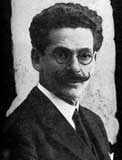
Maestro Serrano
Composer of the Obligatory Piece of the Third SectionObligatory Piece:
"La Venta de los Gatos" Intermedio
Born in Sueca on the 14 October 1873 he was, like many zarzuela composers,
introduced to band music by his father. At the age of 12 he was playing
the guitar and violin, and by the age of 16 he was studying in the Valencia
conservatory under Salvador Giner. Here he studied violin, composition
and piano - an instrument he found difficult to play and soon abandoned.
He then went to Madrid in hope of finding a grant to continue his studies.
However, it was very different world from the Valencia he had left behind
and he initially failed to prosper. He managed to survive writing songs
for other artists at 25 pesetas apiece.
The increasing blindness of Fernández Caballero obliged him to
ask for Serrano's help in finishing the composition of 'Gigantes y Cabezudos',
and this experience was later described by Serrano in an article he wrote
for El Saloncillo magazine.
Serrano received his first big opportunity in 1900 when the famous Álvarez
Quintero brothers generously commissioned him to write the score for their
new zarzuela 'El Motete'. He became an increasingly popular exponent of
the style termed genero chico. Among his most famous works for the theatre
are: La Reina Mora (1903) with text by the Álvarez Quintero brothers,
Moros and Cristianos (1905), El Perro Chico (1905), El Pollo Tejada (1906)
and El Príncipe Carnaval (1919), Alma de Dios (1907), La Alegría
del Batallón (1909), El Amigo Melquiades (1914), La Canción
del Olvido (1916), Los de Aragón (1927), Los Claveles (1929) and
La Dolorosa (1930).
He also wrote the Hymn to Valencia for the regional exposition of 1909.
The song's popularity was such that it became accepted as the regional
anthem in 1925. Seranno died in Madrid in 1941 - before being able to
see two of his works performed, the Golondrina and the 'La venta de los
Gatos'.